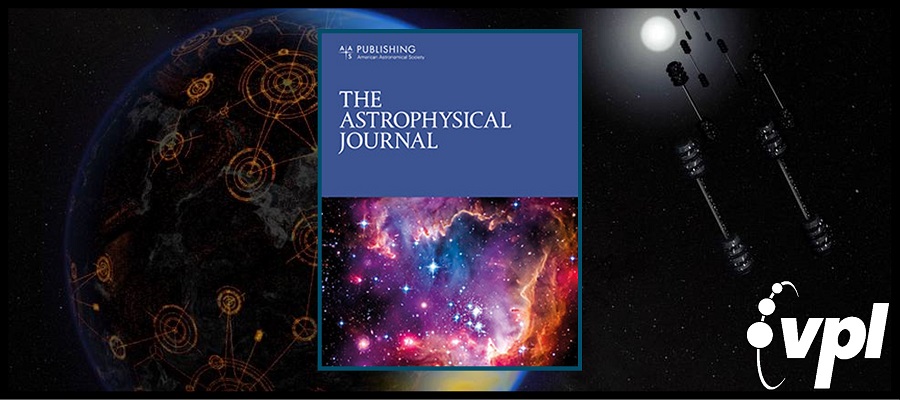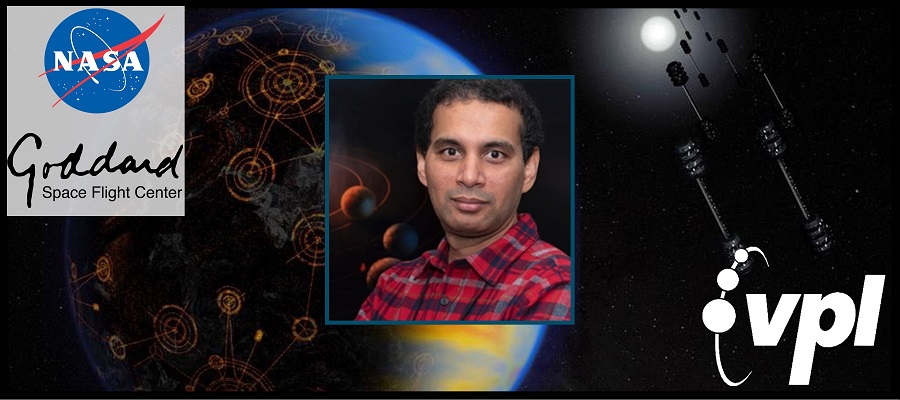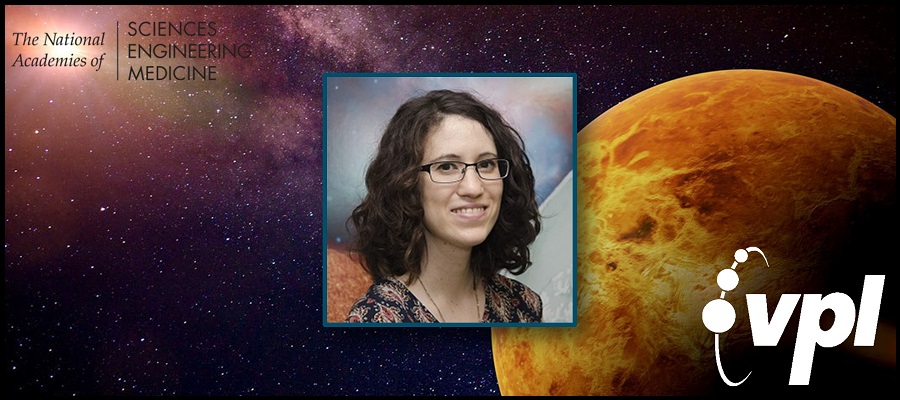VPL Postdoctoral Researcher, Andrew Lincowski (University of Washington), and VPL project PI, Victoria Meadows (University of Washington), published two new…
The observation of a 266.94 GHz feature in the Venus spectrum has been attributed to phosphine (PH3) in the Venus clouds, suggesting unexpected geological, chemical, or even biological processes. Since both PH3 and sulfur dioxide (SO2) are spectrally active near 266.94 GHz, the contribution to this line from SO2 must be determined before it can be attributed, in whole or part, to PH3. An undetected SO2 reference line, interpreted as an unexpectedly low SO2 abundance, suggested that the 266.94 GHz feature could be attributed primarily to PH3. However, the low SO2 and the inference that PH3 was in the cloud deck posed an apparent contradiction. Here we use a radiative transfer model to analyze the PH3 discovery, and explore the detectability of different vertical distributions of PH3 and SO2. We find that the 266.94 GHz line does not originate in the clouds, but above 80 km in the Venus mesosphere. This level of line formation is inconsistent with chemical modeling that assumes generation of PH3 in the Venus clouds. Given the extremely short chemical lifetime of PH3 in the Venus mesosphere, an implausibly high source flux would be needed to maintain the observed value of 20 ± 10 ppb. We find that typical Venus SO2 vertical distributions and abundances fit the JCMT 266.94 GHz feature, and the resulting SO2 reference line at 267.54 GHz would have remained undetectable in the ALMA data due to line dilution. We conclude that nominal mesospheric SO2 is a more plausible explanation for the JCMT and ALMA data than PH3.
VPL Team members Ravi Kopparapu, Giada Arney, Jacob Haqq-Misra, and Jacob Lustig-Yaeger, recently submitted a new study for publication exploring…
Deputy PI and Task B Co-Lead, Giada Arney, and one of the VPL team’s resident Venus experts, was recently honored…
Giada Arney works at NASA Goddard Space Flight Center and as part of the VPL team is the Project Deputy…
Are we alone in the universe? How did life arise on our planet? How do we search for life beyond…
We present self-consistent three-dimensional climate simulations of possible habitable states for the newly discovered habitable-zone Earth-sized planet TOI-700 d. We explore a variety of atmospheric compositions, pressures, and rotation states for both ocean-covered and completely desiccated planets in order to assess the planet’s potential for habitability. For all 20 of our simulated cases, we use our climate model outputs to synthesize transmission spectra, combined-light spectra, and integrated broadband phase curves. These climatologically informed observables will help the community assess the technological capabilities necessary for future characterization of this planetas well as similar transiting planets discovered in the futureand will provide a guide for distinguishing possible climate states if one day we do obtain sensitive spectral observations of a habitable planet around an M star. We find that TOI-700 d is a strong candidate for a habitable world and can potentially maintain temperate surface conditions under a wide variety of atmospheric compositions. Unfortunately, the spectral feature depths from the resulting transmission spectra and the peak flux and variations from our synthesized phase curves for TOI-700 d do not exceed 10 ppm. This will likely prohibit the James Webb Space Telescope from characterizing its atmosphere; however, this motivates the community to invest in future instrumentation that perhaps can one day reveal the true nature of TOI-700 d and to continue to search for similar planets around less distant stars.
We observed the 2019 January total lunar eclipse with the Hubble Space Telescope’s STIS spectrograph to obtain the first near-UV (17003200 Å) observation of Earth as a transiting exoplanet. The observatories and instruments that will be able to perform transmission spectroscopy of exo-Earths are beginning to be planned, and characterizing the transmission spectrum of Earth is vital to ensuring that key spectral features (e.g., ozone, or O3) are appropriately captured in mission concept studies. O3 is photochemically produced from O2, a product of the dominant metabolism on Earth today, and it will be sought in future observations as critical evidence for life on exoplanets. Ground-based observations of lunar eclipses have provided the Earth’s transmission spectrum at optical and near-IR wavelengths, but the strongest O3 signatures are in the near-UV. We describe the observations and methods used to extract a transmission spectrum from Hubble lunar eclipse spectra, and identify spectral features of O3 and Rayleigh scattering in the 30005500 Å region in Earth’s transmission spectrum by comparing to Earth models that include refraction effects in the terrestrial atmosphere during a lunar eclipse. Our near-UV spectra are featureless, a consequence of missing the narrow time span during the eclipse when near-UV sunlight is not completely attenuated through Earth’s atmosphere due to extremely strong O3 absorption and when sunlight is transmitted to the lunar surface at altitudes where it passes through the O3 layer rather than above it.
Are we alone in the universe? How did life arise on our planet? How do we search for life beyond Earth? These profound questions excite and intrigue broad cross sections of science and society. Answering these questions is the province of the emerging, strongly interdisciplinary field of astrobiology. Life is inextricably tied to the formation, chemistry, and evolution of its host world, and multidisciplinary studies of solar system worlds can provide key insights into processes that govern planetary habitability, informing the search for life in our solar system and beyond. Planetary Astrobiology brings together current knowledge across astronomy, biology, geology, physics, chemistry, and related fields, and considers the synergies between studies of solar systems and exoplanets to identify the path needed to advance the exploration of these profound questions.
Planetary Astrobiology represents the combined efforts of more than seventy-five international experts consolidated into twenty chapters and provides an accessible, interdisciplinary gateway for new students and seasoned researchers who wish to learn more about this expanding field. Readers are brought to the frontiers of knowledge in astrobiology via results from the exploration of our own solar system and exoplanetary systems. The overarching goal of Planetary Astrobiology is to enhance and broaden the development of an interdisciplinary approach across the astrobiology, planetary science, and exoplanet communities, enabling a new era of comparative planetology that encompasses conditions and processes for the emergence, evolution, and detection of life.
Full Citation: Meadows V. S., Arney G. N., Des Marais D. J., and Schmidt B. E. (2020). Preface. In Planetary…
The development of astrobiology, the study of life in the universe, is intimately tied to the development of spaceflight in the mid to late twentieth century, which enabled the discovery and exploration of non-Earth environments that might harbor life. In 1976, the Viking missions to Mars supported a core goal to search for signs of life beyond Earth (Klein et al., 1972). However, the Viking life detection experiments provided inconclusive evidence of organics and life (e.g., Klein, 1979; Biemann, 1979; Quinn et al., 2013), a result that put a damper on both Mars exploration and exobiology (as astrobiology was known…
A major focus of astrobiology is the search for habitable conditions and life beyond Earth. We have scrutinized Earth intensely to understand how we might search for habitable conditions elsewhere. In many ways, Venus is the most Earth-like planet in the solar system with its similar mass, radius, and bulk density. Indeed, it is likely that Venus and Earth had very similar starting conditions in terms of their relative compositions of both volatiles and refractory compounds. Yet Earth has been habitable since at least the start of the Archean geological eon (about 3.8 b.y. ago) and possibly during the Hadean…
The TRAPPIST-1 system, consisting of an ultracool host star having seven known Earth-sized planets, will be a prime target for atmospheric characterization with the James Webb Space Telescope (JWST). However, the detectability of atmospheric molecular species may be severely impacted by the presence of clouds and/or hazes. In this work, we perform 3D general circulation model (GCM) simulations with the LMD-G model supplemented by 1D photochemistry simulations at the terminator with the Atmos model to simulate several possible atmospheres for TRAPPIST-1e, 1f, and 1g: (1) modern Earth, (2) Archean Earth, and (3) CO2-rich atmospheres. The JWST synthetic transit spectra were computed using the GSFC Planetary Spectrum Generator. We find that the TRAPPIST-1e, 1f, and 1g atmospheres, with clouds and/or hazes, could be detected using JWST’s NIRSpec Prism from the CO2 absorption line at 4.3 ?m in less than 15 transits at 3? or less than 35 transits at 5?. However, our analysis suggests that other gases would require hundreds (or thousands) of transits to be detectable. We also find that H2O, mostly confined in the lower atmosphere, is very challenging to detect for these planets or similar systems if the planets’ atmospheres are not in a moist greenhouse state. This result demonstrates that the use of GCMs, self-consistently taking into account the effect of clouds and subsaturation, is crucial to evaluate the detectability of atmospheric molecules of interest, as well as for interpreting future detections in a more global (and thus robust and relevant) approach.
Transit spectroscopy of terrestrial planets around nearby M dwarfs will be a primary goal of space missions in coming decades. Three-dimensional climate modeling has shown that slow-synchronous rotating terrestrial planets may develop thick clouds at the substellar point, increasing the albedo. For M dwarfs with T eff > 3000 K, such planets at the inner habitable zone (IHZ) have been shown to retain moist greenhouse conditions, with enhanced stratospheric water vapor (fH 2O > 10?3) and low Earth-like surface temperatures. However, M dwarfs also possess strong UV activity, which may effectively photolyze stratospheric H2O. Prior modeling efforts have not included the impact of high stellar UV activity on the H2O. Here, we employ a 1D photochemical model with varied stellar UV, to assess whether H2O destruction driven by high stellar UV would affect its detectability in transmission spectroscopy. Temperature and water vapor profiles are taken from published 3D climate model simulations for an IHZ Earth-sized planet around a 3300 K M dwarf with an N2H2O atmosphere; they serve as self-consistent input profiles for the 1D model. We explore additional chemical complexity within the 1D model by introducing other species into the atmosphere. We find that as long as the atmosphere is well-mixed up to 1 mbar, UV activity appears to not impact detectability of H2O in the transmission spectrum. The strongest H2O features occur in the James Webb Space Telescope MIRI instrument wavelength range and are comparable to the estimated systematic noise floor of ~50 ppm.
coronagraph is an open-source Python package for generalized telescope noise modeling for extrasolar planet (exoplanet) science. This package is based on Interactive Data Language (IDL) code originally developed by T. Robinson (Robinson, 2018), and described in detail with science applications in (Robinson, Stapelfeldt, & Marley, 2016).
The current goals of the astrobiology community are focused on developing a framework for the detection of biosignatures, or evidence thereof, on objects inside and outside of our solar system. A fundamental aspect of understanding the limits of habitable environments (surface liquid water) and detectable signatures thereof is the study of where the boundaries of such environments can occur. Such studies provide the basis for understanding how a once inhabitable planet might come to be uninhabitable
Oxygen and methane are considered to be the canonical biosignatures of modern Earth, and the simultaneous detection of these gases in a planetary atmosphere is an especially strong biosignature. However, these gases may be challenging to detect together in the planetary atmospheres because photochemical oxygen radicals destroy methane. Previous work has shown that the photochemical lifetime of methane in oxygenated atmospheres is longer around M dwarfs, but M dwarf planet habitability may be hindered by extreme stellar activity and evolution. Here, we use a 1D photochemical-climate model to show that K dwarf stars also offer a longer photochemical lifetime of methane in the presence of oxygen compared to G dwarfs. For example, we show that a planet orbiting a K6V star can support about an order of magnitude more methane in its atmosphere compared to an equivalent planet orbiting a G2V star. In the reflected-light spectra of worlds orbiting K dwarf stars, strong oxygen and methane features could be observed at visible and near-infrared wavelengths. Because K dwarfs are dimmer than G dwarfs, they offer a better planet-star contrast ratio, enhancing the signal-to-noise ratio (S/N) possible in a given observation. For instance, a 50 hr observation of a planet at 7 pc with a 15 m telescope yields S/N = 9.2 near 1 ?m for a planet orbiting a solar-type G2V star, and S/N = 20 for the same planet orbiting a K6V star. In particular, nearby mid-late K dwarfs such as 61 Cyg A/B, Epsilon Indi, Groombridge 1618, and HD 156026 may be excellent targets for future biosignature searches.
The TRAPPIST-1 planetary system provides an unprecedented opportunity to study terrestrial exoplanet evolution with the James Webb Space Telescope (JWST) and ground-based observatories. Since M dwarf planets likely experience extreme volatile loss, the TRAPPIST-1 planets may have highly evolved, possibly uninhabitable atmospheres. We used a versatile, 1D terrestrial planet climate model with line-by-line radiative transfer and mixing length convection (VPL Climate) coupled to a terrestrial photochemistry model to simulate environmental states for the TRAPPIST-1 planets. We present equilibrium climates with self-consistent atmospheric compositions and observational discriminants of postrunaway, desiccated, 10–100 bar O2- and CO2-dominated atmospheres, including interior outgassing, as well as for water-rich compositions
(The Astrophysical Journal, 2018)
“A group of leading researchers in astronomy, biology and geology have come together under NASA’s Nexus for Exoplanet System Science, or…
Proxima Centauri b provides an unprecedented opportunity to understand the evolution and nature of terrestrial planets orbiting M dwarfs. Although Proxima Cen b orbits within its star’s habitable zone, multiple plausible evolutionary paths could have generated different environments that may or may not be habitable. Here, we use 1-D coupled climate-photochemical models to generate self-consistent atmospheres for several evolutionary scenarios, including high-O2, high-CO2, and more Earth-like atmospheres, with both oxic and anoxic compositions. We show that these modeled environments can be habitable or uninhabitable at Proxima Cen b’s position in the habitable zone. We use radiative transfer models to generate synthetic spectra and thermal phase curves for these simulated environments, and use instrument models to explore our ability to discriminate between possible planetary states.
O2 and O3 have been long considered the most robust individual biosignature gases in a planetary atmosphere, yet multiple mechanisms that may produce them in the absence of life have been described. However, these abiotic planetary mechanisms modify the environment in potentially identifiable ways. Here we briefly discuss two of the most detectable spectral discriminants for abiotic O2/O3: CO and O4. We produce the first explicit self-consistent simulations of these spectral discriminants as they may be seen by James Webb Space Telescope (JWST). If JWST-NIRISS and/or NIRSpec observe CO (2.35, 4.6 μm) in conjunction with CO2 (1.6, 2.0, 4.3 μm) in the transmission spectrum of a terrestrial planet it could indicate robust CO2 photolysis and suggest that a future detection of O2 or O3 might not be biogenic. Strong O4 bands seen in transmission at 1.06 and 1.27 μm could be diagnostic of a post-runaway O2-dominated atmosphere from massive H-escape. We find that for these false positive scenarios, CO at 2.35 μm, CO2 at 2.0 and 4.3 μm, and O4 at 1.27 μm are all stronger features in transmission than O2/O3 and could be detected with S/Ns gsim 3 for an Earth-size planet orbiting a nearby M dwarf star with as few as 10 transits, assuming photon-limited noise. O4 bands could also be sought in UV/VIS/NIR reflected light (at 0.345, 0.36, 0.38, 0.445, 0.475, 0.53, 0.57, 0.63, 1.06, and 1.27 μm) by a next generation direct-imaging telescope such as LUVOIR/HDST or HabEx and would indicate an oxygen atmosphere too massive to be biologically produced.
The warm sub-Neptune GJ1214b has a featureless transit spectrum that may be due to the presence of high and thick clouds or haze. Here, we simulate the atmosphere of GJ1214b with a 3D General Circulation Model for cloudy hydrogen-dominated atmospheres, including cloud radiative effects. We show that the atmospheric circulation is strong enough to transport micrometric cloud particles to the upper atmosphere and generally leads to a minimum of cloud at the equator.





